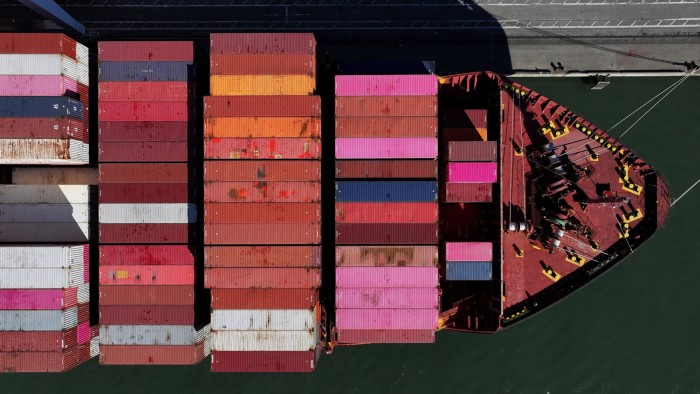Unlock the Editor’s Digest for free
Roula Khalaf, Editor of the FT, selects her favourite stories in this weekly newsletter.
Is the market economy and open trade in global retreat? That depends where you look.
If you look at the surge in government subsidies, regulations and other industrial policy interventions in recent years, you’ll definitely think so. If you observe the political toxicity of trade and trade agreements in the US, you’ll be confirmed in your gloom (or glee, au choix).
On the other hand, if you look at the low and falling average global level of import tariffs and the robustness of goods trade itself you’ll feel much cheerier (or sadder). And checking out the number of preferential trade deals being signed worldwide will make you positively ecstatic (or heartbroken).
Is there a way of reconciling these and remaining optimistic about globalisation? Yes. It rests on the observation that most countries, the US being a conspicuous exception, have chosen a model where even extensive state intervention is mainly kept behind the border. The surge in industrial policy may distort trade, but it is not ending it.
There’s undoubtedly been a sharp increase in corporate subsidies and industrial policy actions (regulations, local content requirements and the like) favourable to domestic companies. They shot up quickly during the Covid pandemic as governments intervened to keep businesses alive. The modish aims of delivering “economic security” and seeking early-mover advantage in technologies such as semiconductors and electric vehicles have now given them a new rationale.
Subsidies can be precisely targeted at favoured sectors and companies. Bigger countries can use national development banks such as Brazil’s BNDES to direct state support. But relatively few measures involve large-scale border restrictions. The only discernible rise in import tariffs among major groups of countries between 2012 and 2022 was a small tick up in tariffs imposed by rich nations, which reflects the US’s protectionist campaign against China.


Governments, wisely, seem to have absorbed the lesson that the economies of scale and specialisation brought by trade are valuable. If a foreign exporter can compete against even a subsidised domestic producer, so be it.
They have also generally adopted interventions relatively respectful of trade law. They have favoured domestic handouts, which can be made compatible with WTO rules, rather than export subsidies for manufactured goods, which cannot.

Meanwhile, emerging markets’ commitment to signing preferential trade deals is striking. The updated Trans-Pacific Partnership of Asia-Pacific countries, which the US first championed and then abandoned, now has 11 members, with another — the UK — joining this week, seven applications including China and Taiwan pending and several more interested. The African Continental Free Trade Area, though very much a work in progress, has 54 signatory countries. The South American trade bloc of Mercosur recently signed a long-awaited deal with Brussels, and resistance to ratification comes overwhelmingly from within the EU, not the Mercosur countries.

Most governments seem to be adopting a rough counterpart to the growth model followed by the successful east Asian tiger economies from the 1960s onwards. Certainly, they subsidised and regulated, sometimes with favouritism that often slid into crony capitalism and sometimes with targeted import restrictions. But in general they remained open to trade and at the least keen on exports, and thus subjected their companies to bracing competition.
The other model was import substitution, favoured by many sub-Saharan African and Latin American countries from the 1960s and 1970s, which aimed to build manufacturing industry behind tariff walls. It led to massive inefficiencies, such as Brazil’s notoriously self-destructive attempt in the 1970s and 1980s to create a domestic computer industry.
It’s noticeable in the EU-Mercosur deal that Argentina and Brazil, the bloc’s two biggest economies, have moved away from their historical import-substituting ideology. The deal liberalises trade while maintaining judicious tools for targeted intervention, including easing their car industries’ transition and reserving some minerals for domestic producers.
As for China, the emerging market behemoth, the state handed out large-scale R&D and production subsidies to build the world’s leading EV industry. But although it also employed trade restrictions, the domestic EV market is saturated and Chinese companies are having to compete internationally, either through exports or investment abroad.
The outlier is the US which, ironically given its postwar commitment to open trade, often follows something closer to import substitution. Despite early-mover advantage with the existence of Tesla, the country’s EV industry is now largely aimed at the domestic North American market. Despite funding from President Joe Biden’s Inflation Reduction Act, it has failed to innovate, skulking behind massive tariff walls. Relative to Chinese car models, which have improved beyond imagination in recent years, Detroit’s EVs look increasingly like classic products of import substitution: clunky, expensive and unlikely to survive in the wild of the global market.
To be fair, the US has such a large domestic consumer market that import substitution could work better than elsewhere. But Washington should not assume other countries will choose the same path or share its visceral aversion to trade deals.
Globalisation has taken a distinct course correction over recent years. State intervention in the economy is newly respectable, though it’s unclear whether governments will persist if they perceive the fiscal cost of subsidies and the efficiency losses from regulation to outweigh the benefits. But for the moment, much of the openness of goods trade of recent decades endures. Governments, reasonably enough, are engaging in trial and error with industrial policy. But happily, few outside the US are discarding open trade as part of their experiments.
alan.beattie@ft.com
Read the full article here











